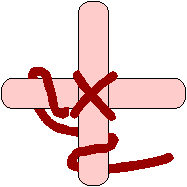My go-to guide for dyeing yarn with Kool-Aid is the 2002 article in the online magazine Knitty, which can be found here:
http://www.knitty.com/ISSUEfall02/FEATdyedwool.html It's got explicit directions, as well as samples of what colors you get from different flavors of the drink mix. I've tried the directions, and they work well at home and only require standard kitchen equipment.
Additional information for the lecture this week came from
http://www.colour-experience.org/teknicolour/teknol_historical/teknol_historical_1.htm
More information and activities for modern dyes:
http://www.rsc.org/Chemsoc/Activities/Perkin/2006/index.html
Craft project for natural dyes:
http://tlc.howstuffworks.com/family/nature-craft-activities-for-kids4.htm
********************
Yarn: Sensations Kashmira, which is readily available at JoAnn Fabrics. Any yarn with a high content of wool or other animal fiber could be substituted, but keep in mind that anything that is mostly cotton or acrylic won't hold the dye. Dyed yarn should be colorfast and safe to hand-wash, but it will fade in the light and will probably felt if washed in a machine.
Dye: One packet of Kool-Aid per 20-yard hank of yarn. The article says you can dye up to an ounce of wool with one packet, but for the most saturated colors, use more Kool-Aid and less yarn.
Dye pots: We're using plastic leftover containers I bought at the grocery store. In the past I've used Pyrex custard cups, Corelle bowls, and glass casserole dishes. You want something that's wide and shallow to make it easy to reach the yarn and have it spread out enough to get good contact with the dye. It also needs to be microwaveable and something that you don't mind getting a little stained (which usually doesn't happen, but I'd hate for you to be disappointed when it did).
Stirring: We're using chopsticks, but you could also use plastic spoons or other disposable items.
********************
Educators: when you're dyeing hanks of yarn with a class full of kids, you have to do things a wee bit differently. Here's what I did:
- Selected inexpensive yarn - one skein of Sensations Kashmira from JoAnn Fabrics was enough for 10 hanks that are about 20 yards each.
- Wound the hanks, then tied each one with acrylic yarn at three places to keep it from tangling when being manhandled.
- Prepared the hanks by dunking them in slightly soapy water and squeezing them gently to get them thoroughly wet. I did this a few at a time in a basin of water, then wrung each hank out and rinsed it in running water.
- Prepared the "dye pots," which were inexpensive plastic storage containers (shallow, large footprint containers work best), by placing a damp hank of yarn in each and adding a shot of clear water to keep it wet until class time. Each child has one dye pot.
- Gathered the rest of my materials, including: a plastic tarp to protect the work area, several disposable chopsticks to use for stirring, a few plastic drinking cups we could use to transfer water, one package of Kool-Aid for each child, a roll of paper towels, a large container of water (there isn't a water supply in the classroom), and a bath towel I didn't mind staining. The children already had smocks at school to cover their clothes.
- Each child got a dye pot with damp yarn inside, and a packet of drink mix. They took the yarn out of the pot, emptied the drink mix into the pot, then added about 1/2 cup water and stirred the mix until it dissolved. Then they added the yarn, squished it down into the dye, and added enough water to cover the yarn completely.
- I took the sealed pots to the room with a microwave, and microwaved them until the water in each pot was mostly white or clear - about 5 minutes or so, checking every two minutes.
- I showed the kids the pots before I rinsed them so they could see that the dye had been absorbed, then I took the pots to the bathroom and rinsed each hank separately under warm water, squeezing them firmly to get all the water out. I rolled all of the hanks up in a bath towel and jumped on it a few times to get some more of the water out, then put each hank in a plastic bag with the child's name on it.
















